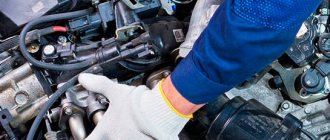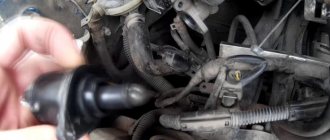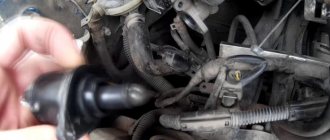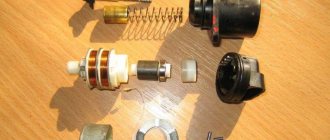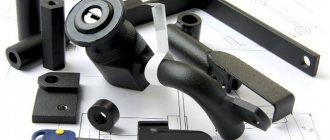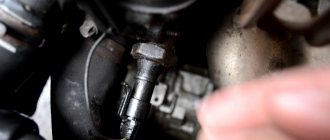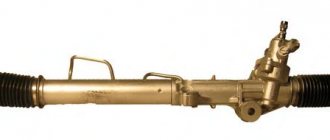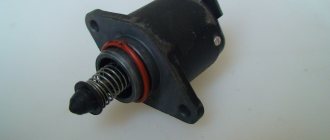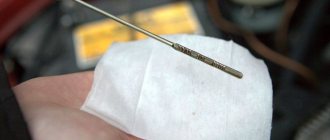Operating principle of IAC
The sensor installed on the engine (mass air flow sensor) determines the volume of incoming air and sends a signal to the ECU, which “gives a command” to “send” the required amount of fuel to the injectors. At the same time, the control unit takes readings from the crankshaft position sensor and controls the operation of the IAC. The last action is expressed in issuing a “command” to open an additional channel.
Another function of the IAC is to adjust the idle speed (700-900 per minute) depending on the engine warming up. If the temperature is insufficient, the ECU “orders” the sensor to increase the passage of the channel: as a result, more air enters the combustion chamber, and the control unit simultaneously supplies more fuel - as a result, the speed increases and the power unit warms up faster. In the same way, using IAC, the ECU takes into account changes in the load on the engine associated with the connection of additional consumers: for example, headlights, interior heater, heated rear window, mirrors, seats, etc. As a result, the engine operates stably at any load.
Tips for extending the service life of IACs
To increase the service life of the sensor, you need to follow simple rules:
- The air filter device must be replaced on time.
- You cannot park your vehicle for long periods of time in winter. At low negative temperatures, the car owner must periodically start the power unit, warm it up and perform gas changes. This will allow the valve to be designed to prevent it from sticking.
- Do not allow foreign liquids to enter the throttle mechanism area. Sprays for quick starting of the engine usually do not pose a danger to the sensor, but it is better not to overdo it.
IAC design
At its core, it is a stepper-type electric motor equipped with a cone-shaped needle pressed by a spring. The device is placed on a choke with a pair of windings. When one of them receives an impulse from the on-board control unit, the needle takes a step forward. The presence of voltage on the second winding causes the needle to move backward. There is a flange at the end of the IAC housing for easy fastening using screws or special varnish. The seal is carried out using a rubberized ring.
Cleaning the needle and bypass channel
To provide access to valve parts, removal of the IAC is required using the following technology:
- disconnecting the block from the connector;
- cleaning the connector contacts and plug with a cotton swab soaked in WD-40;
- unscrewing screws with a curved screwdriver;
- removing the regulator to check the condition.
IAC cleaning
Attention: There is no need to disassemble the regulator, just spray the spring and rod with needle with WD-40 spray, wait for it to dry, and at the same time clean the throttle bypass channel.
The adjustment is made by the on-board network controller itself. However, for stable operation of the engine, you should check the distance from the mounting flange to the protruding needle cone. By default it should be 23 mm.
Types of idle speed sensors
The simplest version of the device is made on the basis of a solenoid - a coil. When voltage is applied to its windings, the core inside jumps out and fits into a special socket, reducing the diameter of the passage channel. As a result, the air supply volume decreases. The simplicity of the design of this type of idle air control guarantees its low cost. But there is also a serious disadvantage: the impossibility of fine-tuning the throughput of the additional channel. This is due to the fact that the idle air control valve only functions in the open or closed position.
There is another type of IAC - rotary. The operating principle of this device is similar to the previous one. But there is an important difference: the opening and closing of the bypass channel is carried out by a rotor, which ensures smooth operation of the regulator. However, today the stepper device has gained popularity. Its design includes a ring magnet, a rotor and 4 windings. Each of them receives voltage from the ECU. As a result, the rotor rod begins to rotate, which is screwed into the channel, blocking it to the desired value.
Principle of operation
The operating principle of the valve is as follows:
- The control unit calibrates the sensor readings if it is detected in the system.
- The controller itself is a stepper electric motor. It is equipped with a conical needle, which is located in a special hole in the throttle valve channel.
- The regulator does not transmit information to the microprocessor module, but receives it from it. Therefore, it is more correct to call it not a sensor, but an actuator - a valve.
- The control unit determines, based on a signal from the flow meter, that there is no air in the combustible mixture. It then compares these impulses with those transmitted by the TPS.
- The regulator device receives voltage. This causes the needle to move out of the canal. the missing volume of air is supplied to the combustible mixture for mixing.
The microprocessor module also receives pulses about the temperature level of the coolant and engine fluid. If the engine starts at low negative temperatures, it must be warmed up, which will reduce wear on friction elements and units. To enrich the mixture, the idle speed sensor channel opens slightly; for this, the driver does not need to press the gas.
At the beginning of the device operation, the action algorithm is as follows:
- The key turns in the lock and the ignition is activated.
- The rod extends all the way. Thanks to this, the needle closes the bypass channel.
- When the rod rests against the calibration hole, the control unit begins to count steps backward.
- Voltage is applied to the windings. As a result, the valve returns to its original open state.
The number of reverse steps is adjusted when flashing the control unit; this indicator may vary depending on the device model. For example, on a Bosch ECU it is 50 steps, and on January modules it is 120.
User Dmitry Shark spoke briefly about the principle of operation, as well as about diagnosing the idle speed controller.
Injector
A throttle valve is used at the input of the collector device in injection engines. It is equipped with an individual controller for determining the position at a specific point in time.
When the engine starts or the powertrain stops, the following occurs:
- The microprocessor module receives data on rotation speed.
- Then the control unit analyzes the operation of the power unit and specifies its intended purpose.
- Readings from the throttle controller and air are compared. The control unit determines whether the damper is closed or not. He can also “understand” which mixture is supplied to the cylinders of the power unit - lean or enriched.
- The IAC valve opens. The air flow bypasses the damper. This makes it possible to maintain speed at a certain level, programmed in advance.
In fact, several ignition system devices are involved in this process. If the car engine stops or stalls due to problems, the operation is checked manually. This is due to the fact that there is no feedback from the IAC and the diagnostic system.
Diesel power units are not equipped with a throttle valve, so they do not use idle speed sensors, they are useless.
User Alex ZW spoke in detail about the principle of operation of the IAC controller in a car.
Where is RHH located?
If you have a carburetor engine, then the regulator (in this case it is usually called the idle air solenoid valve) is located on the side of the device itself that prepares the fuel-air mixture. A single wire approaches the device (the second contact of the solenoid coil is connected to the vehicle ground through the carburetor body). Determining the location of the sensor on an injection engine is not so difficult: usually the regulator is installed next to the throttle valve and the TPS sensor, which determines its position. The IAC terminal block has four wires. In most cases, the idle air control is attached with a pair of screws, sometimes it is fixed to the throttle body using varnish.
If the latter method is used on your machine, then be careful when dismantling the device: it is best to first remove the throttle assembly.
Preventive measures
In order not to encounter a complete malfunction of the regulator in the future, it is worth periodically carrying out the cleaning process described above.
How often to carry out the cleaning process depends on how actively you use your vehicle. If the car is a work vehicle, it is recommended to check and clean the sensor once a year; if you use it only for yourself, once every two years will be enough. But, of course, do not forget about the signs of a part malfunction; if they appear, do not delay. This will help you avoid complete failure of the part and enjoy a high-quality ride. Together with you, we come to the conclusion that the part is unpretentious, simple in its functionality and use. Don’t forget: timely detection of a malfunction is the key to overall vehicle productivity. The full operation of the engine depends on the serviceability of each of its components, and if you neglect any part, including the idle speed sensor, this can lead to more labor-intensive repair processes and failure of the entire car.
Checking the idle speed sensor
Diagnosing the part is quite easy, but pay attention to a few points. The first problem may be removing the part; most manufacturers attach the XX sensor to screws, and in extreme cases they can be drilled out, but in some variations the part is mounted on varnish. If your regulator is secured with varnish, be careful not to forcefully remove it, as this may damage the intake part of the car. In your case, it would be correct to completely dismantle the throttle assembly and only then disconnect the IAC.
The easiest way to check is, of course, visual inspection. During a visual inspection, the first thing you should pay attention to is whether the needle is dirty. Also pay attention to the condition of the contacts and the throttle valve itself.
If broken wires are found, they must be returned to their place. Solder them and, to avoid corrosion, treat them with varnish.
It would be appropriate, if possible, to check the IAC with a multimeter or a homemade tester. You can check the resistance with a multimeter, and use a homemade tester (you can make one from a mobile phone charger) to check the stroke of the regulator rod.
If you find that the motor is damaged, the rod is completely worn out, or the cone needle is worn out, the part will need to be replaced. Don’t be too upset about this, the cost of the part will only be about 1000 rubles.
The most typical symptoms of a malfunctioning idle speed sensor
You can determine them immediately after starting the engine: first of all:
- the motor may “catch” and stall immediately after a successful start;
- unstable operation of the power plant when it warms up (idle speed floats both “cold” and “hot”);
- after starting the power plant, its speed does not increase in order to quickly reach the required degrees;
- after the engine reaches the standard temperature, a spontaneous increase or decrease in the idle speed is observed;
- when connecting electricity consumers - headlights, heater, air conditioner, etc., the crankshaft speed drops and does not stabilize.
- the car jerks while driving at low engine speeds;
- After switching from a higher gear to a lower one or vice versa (neutral position of the gearbox), the engine may stall while driving.
It is worth noting here that all of the above signs can appear either individually or simultaneously. In this case, the “Check” lamp may not respond to problems with the idle speed sensor (which is what happens in most cases). If an error is displayed on the instrument panel, this indicates a malfunction of the TPS - damper sensor.
Causes of malfunctions
Most often, the valve does not work due to dirt accumulated inside the bypass channel. Much less often, the integrity of the solenoid windings is damaged. It could also be:
- inconsistency between the ECU firmware and the IAC variety (typical for injection engines).
- excessive needle wear;
- break in the coil;
- lack of winding contacts with leads inside the sensor.
Basic faults
The above symptoms of malfunction usually occur in the following cases:
- the throttle valve bypass channel is clogged with dirt;
- the integrity of the wires or coils is damaged;
- The ECU firmware does not match the IAC modification.
Regulator needle is dirty
Checking using the above methods reveals all the causes of the problem. Whenever disassembling the regulator or throttle assembly, it is recommended to clean the IAC with special liquids/sprays.
How to check the idle air control
The malfunction of this device in cars equipped with an on-board computer can be determined by the error code it produces. For example, for a VAZ2114-15 it is 0505 (IAC malfunction). The numbers 0507 indicate excessively high crankshaft speeds, and 0506 indicate low ones. The ideal option is to test the idle air control at a special stand in a car service center. However, this is quite expensive, especially considering the relatively low cost of the IAC itself. Therefore, it is worth considering the available verification methods.
Diagnostics of IAC on a carburetor engine
Locate the solenoid valve that is screwed into the side of the carburetor. Turn on the ignition and disconnect the wire from the valve, then connect again. Characteristic clicks should be heard. Their absence (provided there is a voltage of 12 volts on the wire approaching the valve) indicates a malfunction of the device.
Manual diagnosis
This is the simplest method and requires a helper to implement it. Algorithm of actions:
- remove the IAC plug from the socket;
- remove the regulator;
- reconnect the connector while holding the IAC in your hands;
- ask an assistant to start the engine: the rod of a working device will completely enter the solenoid at the moment of starting, and then extend back to a certain distance.
Using this method, you can check the functionality of the needle and the integrity of the coil windings. However, it is impossible to determine the consistency of the firmware: the needle must extend to a strictly defined distance. If we follow the principle “from simple to complex,” then the initial stage of testing is discussed above. What's next?
How to check the idle speed sensor using a multimeter
You will need a tester that measures resistance and voltage. To determine possible malfunctions of the idle air regulator, touch contacts C, D and A, B with probes: the tester should show 40-80 Ohms. Next, measure the resistance between pins A, D and C, D: it will be infinitely large. Now turn on the ignition and set the multimeter to voltage measurement mode. Between contacts A, B and C, D, the voltage should be between 12-20 volts.
IAC diagnostics on a homemade stand
If you have minimal experience in soldering radio components, then you can assemble the simplest circuit yourself. For this you will need:
- solder with flux;
- soldering iron;
- mobile phone charger;
- non-polar capacitor 10 µF for a voltage of at least 10 volts;
- plug block from IAC;
- 6 V light bulb;
- any switch with two positions.
This “stand” will help you check the device using impulses. Connect one of the “charging” terminals through the connector to contacts A and C of the idle speed sensor. Connect a light bulb in series to the second wire of the power supply - connect a toggle switch to its other contact. Solder a capacitor parallel to its terminals, which must be simultaneously connected to contacts B and D. Connect the unit to a 220 V network and click the toggle switch: a bright glow of the lamp indicates a malfunction of the regulator, but if it is lit at full intensity, the IAC is normal.
Design features
The valve structurally consists of:
- electric stepper motor;
- four-position rod;
- spring element;
- needles.
When IACs first appeared, they were rotary or solenoid mechanisms. Such devices had two positions - open and closed. This contributed to a decrease in the efficiency of engine speed control. Today, cars use four-step sensors, characterized by the possibility of stepwise feed through the bypass.
The idle air control itself is classified as a consumable item and is therefore considered non-repairable. It can be repaired if it malfunctions, but it will be cheaper to replace it completely.
Location
Externally, the IAC looks quite simple. It looks like a small electric motor. Its design includes three parts:
- Stepper motor;
- Spring;
- A rod with a needle at the end.
And the desired regulator is located near the mechanism that is responsible for changing the position of the throttle valve. There is no complex fastening system. To dismantle you just need to remove the mounting bolts.
Where is RXX located?
The device should be located next to the throttle valve and TPS. In some cars, the sensor can be fixed directly to the damper body using varnish. Sometimes the device is mounted using two bolts equipped with special mounting holes. The main thing is that the distance from the needle to the mounting flange on the installed device is 2.3 cm.
Connection diagram
Idle air controller connection diagram
One harness consisting of four cables is connected to the idle speed sensor; it comes from the microprocessor module. As a result of this connection, diagnostics may cause certain difficulties. The car owner will not be able to simply apply voltage to the terminals of the device, since the microprocessor module does this pulsed.
Restoring the idle speed control
Remove the device by first disconnecting the electrical connector. Turn on the ignition and use a tester or any light bulb with two wires to make sure that the device is receiving power from the on-board network. If everything is fine here, clean the contacts with a cotton swab sprayed with WD40 spray. Use it to treat the additional channel, as well as the rod, spring and needle. The reach of the latter is controlled by the vehicle's control unit. However, in a quiet state, you can check the distance from the end of the needle to the IAC flange at the idle speed sensor: it is 23 mm.
Symptoms and causes of IAC (IAC) malfunction
Signs of a malfunctioning idle speed sensor appear as follows:
Important point! There is a misconception that a regulator failure is necessarily accompanied by the inclusion of the Check Engine indicator on the dashboard. Since the element is an actuator, the light warning option is not provided in all cars.
If the car shows signs of IAC malfunction in the form of floating engine speed at idle, advanced diagnostics may be needed. A spontaneous change in the crankshaft rotation speed occurs for many reasons - failure of a sensor, air leaks, gas distribution malfunctions, and so on. It is better to start troubleshooting by checking the regulator.
IAC failure occurs for three main reasons:
There is a fourth reason - problems with the electronic control unit. The problem is quite rare and is accompanied by additional symptoms - increased gas mileage, unstable operation in all modes, difficult starting, and the like.
Oil deposits reach the rod thanks to secondary gases sent by the crankcase ventilation system for re-combustion. The more worn out the engine, the more deposits accumulate on the working cone. As a result, moving the rod becomes difficult; in advanced cases, the mechanism simply jams.
Features of choosing IAC manufactured in the Russian Federation
The original product has its own marking, in which the last couple of digits indicate device compatibility. Even and odd numbers are interchangeable. For example, instead of a sensor with 01 at the end of the marking, you can install a device with the last digits 03. The same applies to even numbers: IACs marked 02 and 04 are interchangeable. That is, instead of 01 you cannot put 04.
Recently, a lot of counterfeit products have appeared on the auto parts market, including idle air regulators. Sometimes it is possible to identify them by their characteristic features:
- the packaging is not branded - there are no special marks, barcodes, or holographic stickers;
- the sticker on the sensor body is yellow and without an outer frame;
- the needle has a dark shade;
- the rivets on the regulator body do not have heads, the diameter of which should be 3 mm;
- the sealing ring is very thin and is black instead of red;
- spring – white with sparse winding (should be black);
- the body is 1 mm shorter than the original one.
Video “Self-calibration and removal of the rod from the IAC”
User Ruslan K talked about how to remove the needle from the regulator at home and calibrate it without special equipment.
Do you have any questions? Specialists and readers of the AUTODVIG website will help you ask a question
Was this article helpful?
Thank you for your opinion!
The article was useful. Please share the information with your friends.
Yes (100.00%)
No
X
Please write what is wrong and leave recommendations on the article
Cancel reply
Rate this article: ( 2 votes, average: 5.00 out of 5)
Discuss the article:
How to replace the idle speed sensor
Before starting work, remove the negative terminal from the battery. Disconnect the four-pin connector from the sensor to be replaced by first pressing the plastic latch (if available). Remove the pair of screws securing the regulator. Take a new device, lubricate the o-ring, spring and rod with engine oil: this will increase the life of the regulator.
Now you need to calibrate the newly installed product. To do this, put the negative battery terminal in place and turn on the ignition for 15 seconds without starting the engine. During this time, the control unit will calibrate automatically. Next, start the engine and check how the sensor functions on a running power unit. If the idle speed is higher than normal, then the procedure must be repeated (possibly more than once). With the idle speed control operating normally on a cold engine, the tachometer will show approximately 1000 rpm. After reaching operating temperature, they will drop to around 800 rpm. It is worth noting that discrepancies with these indicators may be caused by the use of low-quality fuel.
Sensor diagnostic methods
The easiest way to check that the idle speed sensor is working is to start the engine and remove the power connector from the block. When the element is in good condition, the speed will drop sharply and the engine will stop - when the power supply is turned off, the spring will push the cone forward and the cross-section of the bypass channel will completely close. If the engine operation remains the same or changes slightly, move on to other testing methods.
The next stage of diagnostics is measuring the supply voltage, performed in this order:
Basically, on cars, you can check the performance of the stepper motor without removing it from the car. Using a multimeter, measure the resistance between the following pairs of contacts: A - B, C - D (it should be approximately 53 ohms). Then measure other pairs - A - C, B - D, on a working regulator the device will show infinity.
Further checking of the idle speed sensor is carried out as follows:
Advice. If a strong oil deposit is detected on the working part of the IAC, it is highly advisable to perform the procedure for cleaning the throttle and bypass channel - a similar picture is likely to be observed there.
To install a new regulator, be sure to remove the negative terminal of the battery. After assembly and connection, the IAC controller is calibrated - you need to turn on the ignition and wait 15 seconds. If the battery is not disconnected, the ECU will skip the calibration step, which may cause the engine to run unstably.
Prevention Tips
Recommendations that will increase the service life of the IAC:
- Do not allow liquid to enter the throttle valve. This will cause moisture and dirt to accumulate inside the device.
- It is necessary to monitor the condition of the air filters. The IAC is a flow regulator, so this is important for the sensor.
- If the car is rarely used during the cold season, then you need to find a garage for it. In this case, it is necessary to periodically start and warm up the engine and perform gas changes. This will allow the idle speed controller to develop and not freeze. After a long period of parking in low temperatures, the sensor may jam.
Have you changed the idle speed sensor on your car?
What do you need to know when replacing the IAC?
To change and install a controller that allows you to regulate idle speed, you need to pay attention to the position of the rod. It must not be allowed to be pushed forward too much. This can happen if the device is connected to the block and the ignition is activated before installation. It is not allowed to push the rod in by hand.
If the valve is installed with the needle extended and the retaining screws are tightened, damage to the unit may occur due to shearing of the worm gear. It is impossible to repair such a sensor. Depending on the vehicle model, after installing a new regulator, it may need to be calibrated. In some cars, this procedure is carried out using special equipment or a stand.
On VAZ cars, calibration is performed as follows:
- A terminal is connected to the negative output of the battery.
- The key is turned in the lock to turn on the ignition for ten seconds. There is no need to start the power unit.
- The ignition is turned off.
User Ovsyuk talked about replacing the idle air valve on his own using the example of a Lada Samara car.
Video - Replacing the sensor on a VAZ 2110
Asks
: Vinokurov Ivan.
The essence of the question
: I want to replace the idle speed sensor, but I don’t know where it is located?
Good afternoon, I recently had this problem. When I stop at a traffic light, ! Friends say that the reason may be in the idle speed sensor, but I don’t know where it is located. Please tell me how to find it and how to solve my problem?
Idle speed sensor or, in other words, idle speed regulator ( IAC)
– approx.) is designed for stable engine operation when the gas pedal is released. It is this device that provides a minimum supply of air and fuel when the car is stationary and idling.
The following two tabs change content below.
I own a Renault Megane 2, before that there were Citroens and Peugeots. I work in the service area of a dealership, so I know the car inside and out. You can always contact me for advice.
The incorrect operation of this sensor can be determined by several criteria, and if one of them occurs in the operation of your car, you can safely start cleaning it, or buy a new one in the store. So, the most common symptoms that occur when the idle air regulator fails:
- Starting the engine is very difficult without the help of the gas pedal, or.
- When the car is stopped, the idle speed fluctuates.
- When changing gears, the rpm either drops to about or around this value.
- In cold weather, the engine does not reach more than 1500 rpm when cold.
- When starting up appliances, lights, stoves, heating and other devices, the speed “sags”.
- The engine speed either rises or falls spontaneously, or stops at values exceeding the norm.
